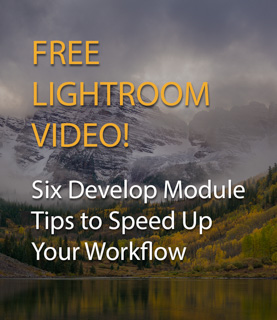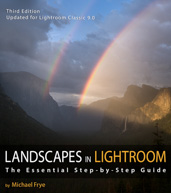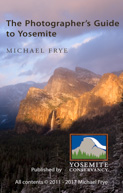Composition
by Michael Frye | Jun 12, 2016 | Composition

Sea stacks and cormorant, Redwood NP, CA, USA
Separating visual elements is a concern in any composition, but seems to be particularly vital when photographing the ocean and forest scenes along the northern California coast. Both sea stacks and redwood trunks need to be well-spaced, balanced, and stand out clearly.
(more…)
by Michael Frye | Feb 14, 2016 | Composition, Vision and Creativity
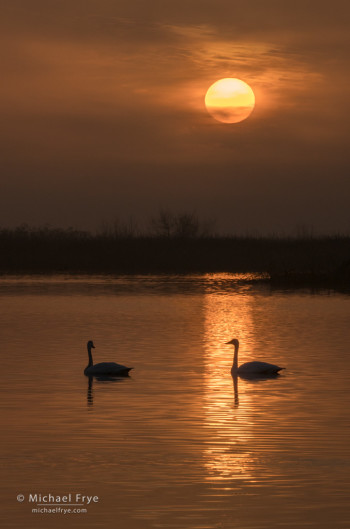
Tundra swans at sunrise in a San Joaquin Valley marsh
Happy Valentine’s Day!
This photograph of tundra swans seemed appropriate today. Swans mate for life, so you always see them in pairs, or in a small group when parents are joined by their young cygnets. The two subjects of this photograph were undoubtedly a mated pair.
One of the challenges of photographing these swans was that they kept their heads underwater for long periods of time while they were feeding. Periodically one of their heads would pop up briefly, but then plunge underwater again, and it was rare for both swans to have their necks raised at the same time. I expended many pixels trying to capture moments when both swans had their heads up. Even when I managed to catch both of them with their heads visible, often one of the swans would have its back to me, or be in some other awkward position.
But I stayed alert and patient, and eventually things came together. Both swans lifted their heads for maybe ten seconds – an eternity, it seemed – while I held down the shutter button. At one point the swan on the left even turned its head and looked back at the swan on the right. Perfect. That little gesture made a big difference in the photograph by creating a visual connection between the two swans.
(more…)
by Michael Frye | Dec 29, 2015 | Advanced Techniques, Composition, Light and Weather

Morning light, Gates of the Valley, Yosemite NP, CA, USA
After the big rainstorm last week I drove up to Yosemite Valley early Wednesday morning. I knew there wouldn’t be fresh snow, but I hoped for some mist and interesting light. It turned out that mist was scarce, probably due to below-freezing overnight temperatures, but there was a little bit here and there.
I stopped at a couple of places, and found myself at Gates of the Valley (aka Valley View) as the sun started to hit El Capitan and light up the clouds above. After making a few photographs with fast shutter speeds, I decided it would be more interesting to smooth out the water with a very slow shutter speed. My seven-stop neutral-density filter did the trick, allowing me to lengthen the exposure to 15 seconds. Thinking about the nighttime panorama I made from this spot recently, I decided to try that again, using my 24mm Rokinon lens in a vertical orientation, and making four exposures to capture the broad sweep of this scene. After a few minutes the light actually got more interesting, with a thin beam of sunlight raking across the face of El Cap.
(more…)
by Michael Frye | Dec 17, 2015 | Composition, Vision and Creativity
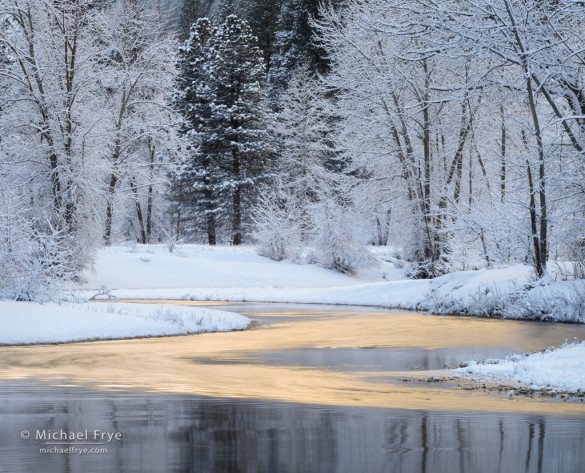
Reflections along the Merced River, winter, Yosemite. I tried several different versions of this photograph. I initially wanted to include a wider view, with more trees on the sides, but a distracting log just out of the frame on the right bothered me. In the end I liked this tighter, simpler, distraction-free version better.
Yosemite Valley received two doses of snow this past weekend, first on Friday night, and then again on Sunday night. I wasn’t able to make it up there on Saturday, but Claudia and I drove up early Monday morning after the second snowfall.
The storm had cleared around midnight, and temperatures then dropped down to 25 degrees. Below-freezing temperatures inhibit the development of fog and mist, so the skies were clear when we arrived in the valley. But we found three to four inches of fresh, fluffy snow coating all the trees.
(more…)
by Michael Frye | Aug 2, 2015 | Composition
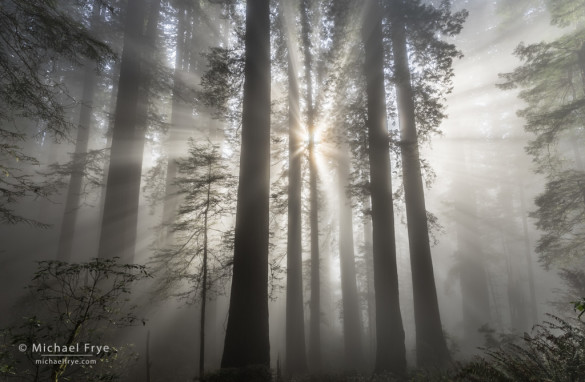
Sunbeams in a redwood forest, northern California coast, USA
When doing critiques I often encounter otherwise-wonderful images, with simple, strong compositions, great light, and nice color, but lacking an essential ingredient: a focal point. Viewers need something to latch onto, and if they don’t find it right away they feel lost. You have to take them by the hand and say, “Here, look at this.”
The photograph above has an obvious focal point — the sun. From there your eyes can travel along the radiating light beams out to the rest of the frame.
(more…)
by Michael Frye | Jul 6, 2015 | Composition, Light and Weather
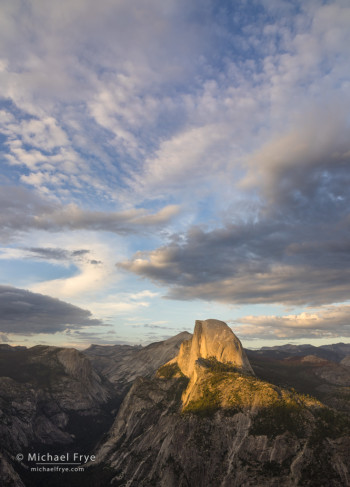
Half Dome from Glacier Point, late afternoon, Yosemite; for a brief moment the clouds formed a zigzag pattern above Half Dome.
Last week I mentioned that the weather forecast called for monsoonal moisture to move up into the Sierra Nevada from the south, with possible showers and thunderstorms. And sure enough, things unfolded pretty much as predicted. Rain was very localized; we got sprinkled on a couple of times at our house in Mariposa, but other nearby areas got dumped on when they received a direct hit from a thunderstorm.
Wednesday night brought thunder to the foothills near our house – that’s when I made the lightning photograph from my last post. But we saw interesting clouds all week. Claudia and I made two trips to Glacier Point, and I also photographed some beautiful moonlit clouds from our driveway, and made a trip into the lower foothills, where I found some striking, colorful sunbeams.
What do all these photographs have in common – aside from clouds? Patterns. All of these images have some kind of repeating pattern or design in the clouds.
(more…)







